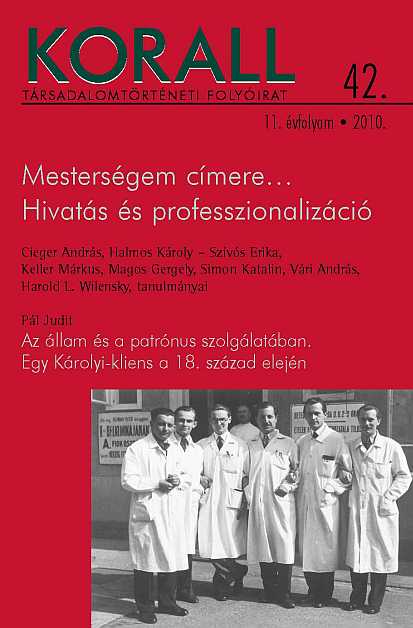Mesterségből hivatás. Sebészmesterek és orvosdoktorok Magyarországon az egységes orvosi képzés bevezetéséig
When Medicine Became Profession. Masters of Surgery and Doctors of Medicine in Hungary before Standardized Medical Training
Author(s): Katalin SimonSubject(s): History
Published by: KORALL Társadalomtörténeti Egyesület
Summary/Abstract: Nowadays doctors are generally appreciated as members of a group, which has great prestige in society. In lay eyes, they share equal rights and regard, independent of the field of medicine. In contrast, in the eighteenth century there where many specialists in the medical market, and each had their own place in society: a) doctors lived mostly in towns and specialized in so-called ‘internal diseases’; b) surgeons, barbers, and bath men lived in towns or villages, and dealt with ‘external diseases’ (although due to the lack of doctores medicinae they also handled other illnesses); c) wayfarer therapeutists (dentists, ophthalmologists and the so-called lithotomi) were specialists with various skills; d) unprofessional healers, for example women with practical knowledge of healing within the family. In the eighteenth century, the state decided to decrease this diversity and take strong control over the rest of these groups, and by this, over the health of its citizens. There were several important milestones in this process. In 1752 each free royal city and county was ordained to employ a doctor. In 1770 the relationship of doctors, surgeons, pharmacists and midwives was stipulated in Maria Theresa’s Generale Normativum. In the same year, the Hungarian Faculty of Medicine opened. By the first half of the nineteenth century only two significant groups remained in the field: doctors and the lower-qualified surgeons. Both acquired their diploma at university, but the company of surgeons was divided into two further branches: the masters of surgery studied almost as long as doctors, so they were more erudite than civil surgeons. The increasing popularity of the faculty from the 1820s resulted in difficulties and fewer work opportunities, and as a consequence, tension flared up between doctors and surgeons. From the eighteenth century, each county accommodated one or two doctors (as physici) and four or five surgeons. Although surgeons took care of most of the population and performed operations, doctors often attacked them, calling their profession obsolete and defective. The first associations were founded in the 1830–1840s. Most of these bodies had doctors, surgeons and pharmacists among their members, only the Royal Company of Doctors in Budapest forbade masters or civil surgeons to join. The debate culminated in 1848, but after the suppression of the Hungarian revolution the old system remained largely unchanged. Many students still made the best of the shorter course of civil surgery, but the number of doctors of medicine (and surgery) was on the rise. Eventually, surgeon training was abolished in the Habsburg Empire and the standardized medical training for doctors of medicinae universalis was established.
Journal: Korall - Társadalomtörténeti folyóirat
- Issue Year: 2010
- Issue No: 42
- Page Range: 77-102
- Page Count: 26
- Language: Hungarian

